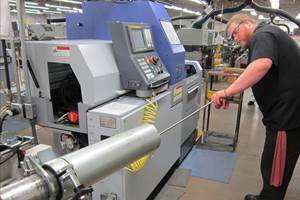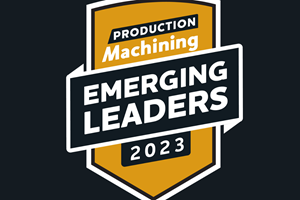Patents are Not Only for Big Business
Patenting should be a part of more small companies’ and inventors’ business plans. The process is less complicated than people realize, and it serves to protect important intellectual property.
While presenting a new product at the 2013 Precision Machining Technology Show (PMTS), Charles Ruecker, CEO and President of Core Powered Inc., began thinking about patents. The company’s 2-axis CNC head designed for high production machine tool applications was getting a lot of attention from customers and equipment manufacturers alike. Mr. Ruecker became concerned about whether Core Powered had taken all the steps possible to protect this product that the company had spent years developing. That’s when it occurred to him that to fully protect this invention he would need to patent it.
Mr. Ruecker had never given much thought to the patent process before, focusing instead on simply creating quality products to meet his customers’ needs. He admits that part of the reason he hadn’t looked into patenting was because he felt daunted by the patent process, a sentiment that probably discourages many small business owners and independent inventors. Thankfully, his experience with patenting was easier than anticipated, and he wants to share his experience with other small businesses and inventors to encourage them to investigate whether patenting is right for them. In his words, “If you don’t have patent on the brain, you should.”
Patents in a Nutshell
A patent is a government grant that gives the holder exclusive rights to make, use, and/or sell a specific invention. Without a patent, anyone can copy, manufacture, and sell someone else’s invention without owing the original creator a cent. Further, there’s nothing to stop a competitor from independently developing the same invention, patenting it, and then demanding that the original inventor cease production.
The definition of a patentable “invention” varies slightly from country to country. In Canada (where Core Powered is headquartered), for example, the Patent Act, RSC 1985, c P-4, s 2 states that a patentable invention is “any new and useful art, process, machine, manufacture, or composition of matter.” A patentable invention must meet the following 3 criteria:
- It must be novel (such as be the first in the world)
- It has to show utility (it has to be functional and do what it’s supposed to do)
- It must be ingenious (it’s not something obvious to someone skilled in its area).
A patentable invention might cause a competitor to see it and exclaim, “Why didn’t I think of that!?” or “I never thought that could work!” or “I never thought this was possible!”
Patents and the patent-application process or the “patent pending” process are highly time sensitive. The first step in obtaining a patent is submitting an application. In many countries a patent application needs to be filed before the invention is publically disclosed. Once it is filed in one country, that first filing date will be recognized in most countries. Essentially this means that an inventor only needs to submit a preliminary application in one country and then a “grace” period” (often one year) is enacted during which the inventor should start submitting complete applications in each country desired.
The Importance of Marketing
There are several ways to make money off of a patented product, the most obvious being to make and sell the product. The other two main options are licensing the manufacturing rights and collecting royalties, or selling the complete rights for one lump sum. However, for any of these avenues to be successful, there must be a market and a demand for the invention. “Lots of great ideas never go anywhere because the word does not get out there,” says Mr. Ruecker. To maximize profits from their innovations, inventors need to make marketing a priority.
While Mr. Ruecker feels the demand is there for Core Powered’s new product he was demonstrating at PMTS, he has added confidence in its success because the company is putting an emphasis on creating a buzz for the product. Unfortunately, the independent inventor often is not well versed in marketing. Mr. Ruecker feels this is particularly true within the manufacturing field. He says, “The same people who are coming up with the product may not be the best people to market it.” He recommends that inventors consult with people who are experts at spreading information and those who have their finger on the pulse of the industry. “Magazine editors know what to do. Visit them at events, tell them about your products,” advises Mr. Ruecker.
Patenting Protects Innovation
Through reflecting on his own experience with the patent process, Mr. Ruecker has concluded that patenting needs to be a part of more small companies’ and inventors’ business plans. He sees lots of great ideas that are being copied and worries that their creators aren’t pursuing patents because they fear the patent process. Therefore, he is motivated to spread the word that it’s really not complicated at all. Mr. Ruecker strongly encourages inventors who think they have a great product to consult a patent lawyer as soon as possible. “The patent can be in process within 24 hours,” he says.
Finally, Mr. Ruecker underscores that patenting is vital to the ongoing success of North American manufacturing. He says, “Patenting is our means of protecting greatness. It’s how we can protect innovation in North America.”
Related Content
6 Tips for Training on a Swiss-Type Lathe
There are nuances to training a person to effectively operate a Swiss-type lathe. A shop I visited a while back offers some suggestions.
Read MoreEmerging Leader's Problem-Solving Skills Cool Down a Hot Project
This 2023 Emerging Leader developed a product in response to a call for help from Yamaha that was a huge hit in the snowmobile industry when it hit the market in 2010. In fact, it is now a common product that most snowmobile OEMs have implemented.
Read More2023 Emerging Leaders Strengthen Their Staffs, Solve Problems
Superb critical thinking, top-notch leadership skills and a passion for building a strong team are a few of the common traits held by this year’s five Production Machining Emerging Leader award winners.
Read MoreEmerging Leader's Dedication to Education
Instilling confidence throughout a shop floor can do wonders for company morale while increasing productivity.
Read MoreRead Next
5 Aspects of PMTS I Appreciate
The three-day edition of the 2025 Precision Machining Technology Show kicks off at the start of April. I’ll be there, and here are some reasons why.
Read MoreEmerging Leaders Nominations Now Open
Here’s your chance to highlight a young person in your manufacturing business who is on the path to be a future leader moving your company forward.
Read MoreA Tooling Workshop Worth a Visit
Marubeni Citizen-Cincom’s tooling and accessory workshop offers a chance to learn more about ancillary devices that can boost machining efficiency and capability.
Read More






















